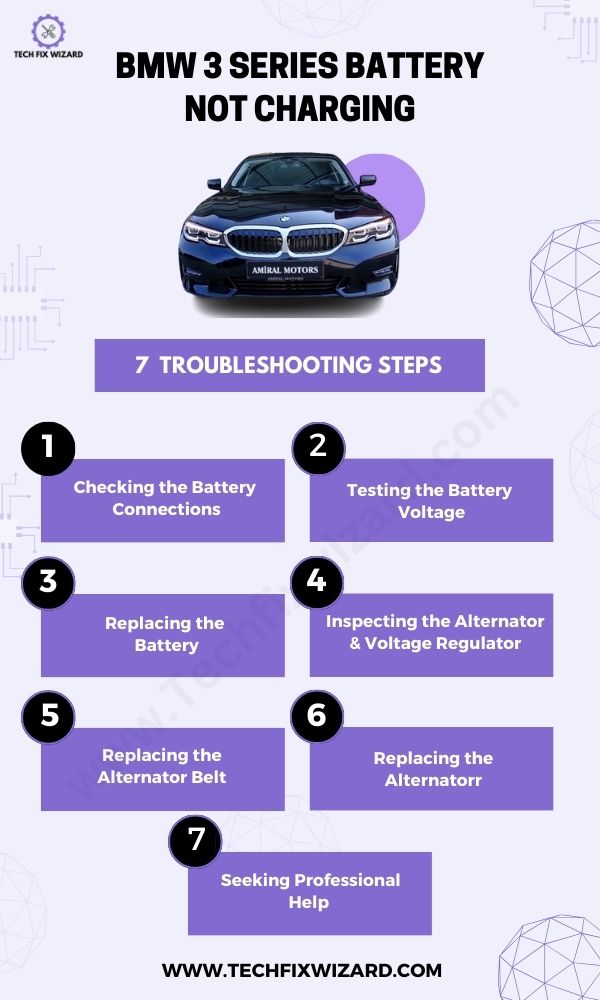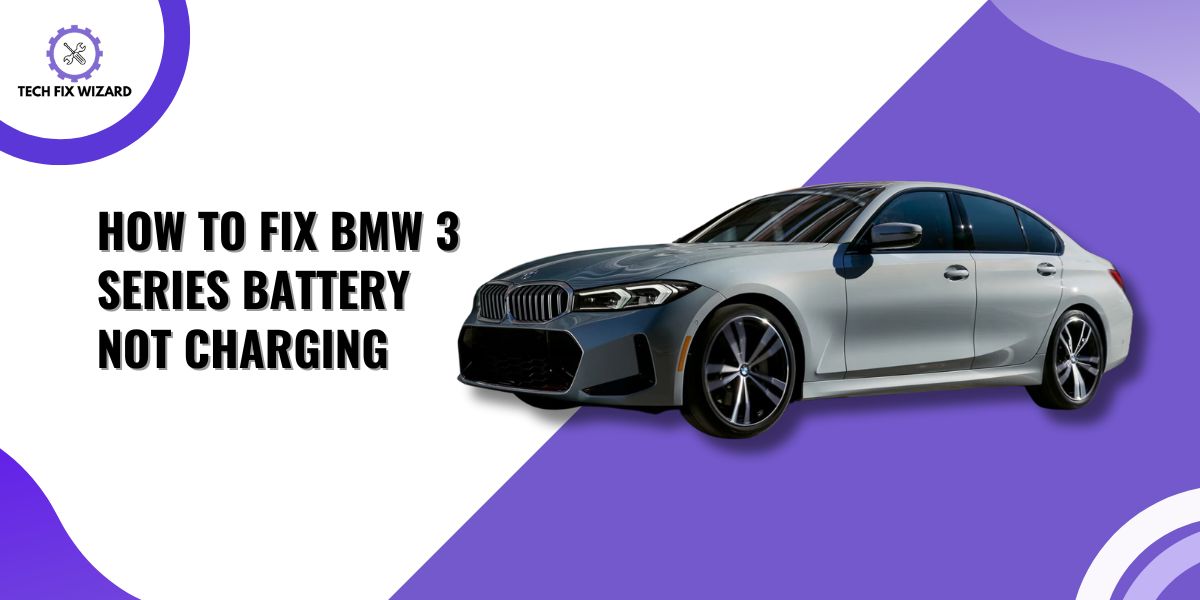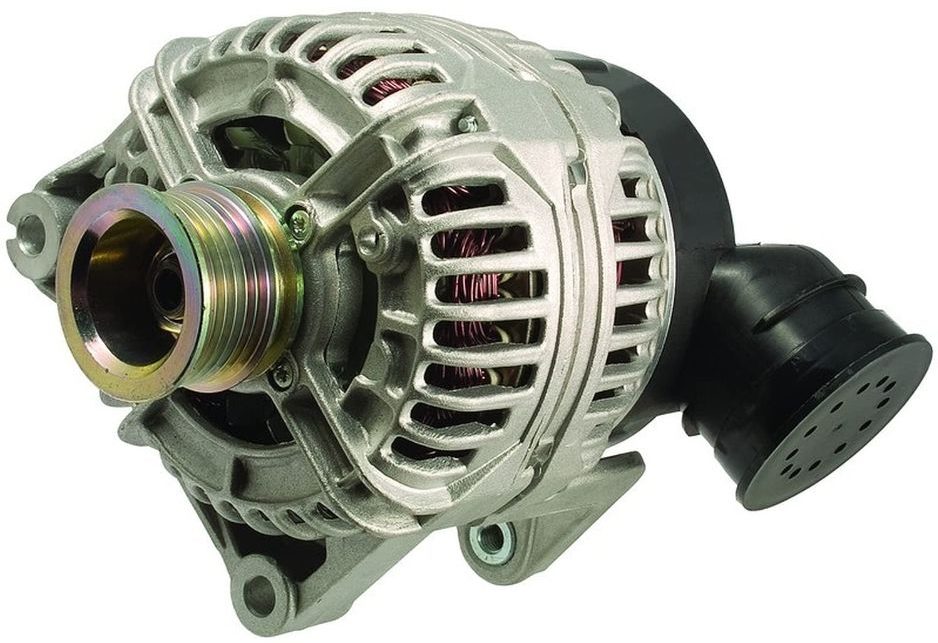If you’re experiencing issues with your BMW 3 Series battery not charging, it can be frustrating and concerning.
Fortunately, there are several steps you can take to diagnose and fix the problem before resorting to costly repairs or replacement.
In this article, we’ll walk you through some common causes of a dead battery in a BMW 3 Series and provide tips on how to get it up and running again.
Contents
- 1 BMW 3 Series Battery Not Charging – Symptoms
- 2 BMW 3 Series Battery Not Charging – 7 Fixes
- 3 1. Checking the Battery Terminals and Connections
- 4 2. Testing the Battery with a Multimeter
- 5 3. Replacing the Battery
- 6 4. Inspecting the Alternator and Voltage Regulator
- 7 5. Replacing the Alternator Belt
- 8 6. Replacing the Alternator
- 9
- 10 7. Seeking Professional Help
- 11 Conducting Regular Maintenance to Prevent Future Issues
- 12 FAQs
- 13 Why is my BMW 3 Series battery not charging?
- 14 How can I tell if my BMW 3 Series battery is dead?
- 15 What should I do if my BMW 3 Series battery is not holding a charge?
- 16 How often should I replace the battery in my BMW 3 Series?
- 17 Can a faulty alternator cause the battery not to charge?
- 18 What are some common signs of a failing alternator in a BMW 3 Series?
- 19 How can I check the battery connections in my BMW 3 Series?
- 20 Can I replace the battery in my BMW 3 Series myself?
- 21 How can I test the alternator in my BMW 3 Series?
- 22 Where can I find a professional BMW service center for battery-related issues?
- 23 Official References & Resources
BMW 3 Series Battery Not Charging – Symptoms
If you’re experiencing a BMW 3 Series battery not charging, it’s important to pay attention to certain symptoms that may indicate a problem before diving into the troubleshooting steps.
Here are 4 common symptoms of a BMW 3 Series battery not charging
- Clicking sound when trying to start the car.
- Dimming headlights.
- Slow engine cranking.
- Difficulty starting the car, especially in cold weather.
BMW 3 Series Battery Not Charging – 7 Fixes
Following are the 7 Troubleshooting steps to resolve BMW 3 series battery not charging issue:

Also Read: BMW 1 Series Battery Not Charging – 8 Practical Steps To Try
1. Checking the Battery Terminals and Connections
Checking the health of your BMW 3 Series battery is of utmost importance when troubleshooting a charging issue.
The battery serves as the heart of the vehicle’s electrical system, providing the necessary power to start the engine and operate various components.
If the battery is weak, damaged, or nearing the end of its lifespan, it can significantly impact the charging process and lead to a BMW not charging.
Here are some steps you can follow to check on them:
- Open the hood of your car and locate the battery. Make sure your car is turned off before proceeding.
- Inspect the terminals for any signs of corrosion, such as a fuzzy white substance around them. If you see this, use a wire brush to clean them off.
- Check that the connections are tight by gently wiggling them with your hand. If they’re loose, use a wrench or pliers to tighten them up.
2. Testing the Battery with a Multimeter
This test helps assess the battery’s voltage and determine if it is functioning properly or requires further attention.
- Turn off the engine and all electrical components such as lights and radio.
- Set the multimeter to DC voltage mode.
- Connect the positive lead (usually red) of the multimeter to the positive terminal of the battery.
- Connect the negative lead (usually black) of the multimeter to the negative terminal of the battery.
- Ensure both leads are securely connected to their respective terminals.
- Take a reading of the voltage displayed on the multimeter.
- If the voltage falls below this range or reads less than 11 volts, the battery may be dead or dying.
- If uncertain about the battery’s condition, try jump-starting it with another vehicle or a portable jump starter kit.
- If jump-starting doesn’t work, consider replacing the battery.
| Battery Voltage Reading | Battery Status |
|---|---|
| 12.7V – 12.4V | Fully charged |
| 12.39V – 11.89V | Needs charging |
| Below 11.89V | Needs immediate charging |
3. Replacing the Battery
If you have determined that the battery in your BMW 3 Series needs replacement, it is crucial to address this issue promptly.
A faulty or weak battery can lead to various problems, including a vehicle not charging properly.
Follow the steps below for replacing the battery:
- Locate the Battery: Find the battery in the engine bay or trunk.
- Prepare Tools: Gather a wrench or pliers for the replacement.
- Disconnect the Battery: Remove the negative terminal first, followed by the positive terminal.
- Remove the Old Battery: Take out the old battery after releasing any securing brackets or clamps.
- Clean Battery Tray: Ensure the battery tray is clean and free of dirt, debris, and corrosion.
- Install the New Battery: Place the new battery securely in the battery compartment.
- Reconnect the Battery: Attach the positive terminal first, then the negative terminal.
- Test and Verify: Start the vehicle and check for the absence of the battery warning light.
You May Also Like: BMW 5 Series Battery Not Charging – 7 Solutions To Try
4. Inspecting the Alternator and Voltage Regulator
After checking the battery and its connections, it’s important to assess the health and functionality of the alternator and voltage regulator, as they play a key role in the charging system
| Step | Description |
|---|---|
| 1. Locate the components | Under the hood of your BMW 3 Series, locate the alternator and voltage regulator. |
| 2. Check wiring connections | Inspect the wiring connections between the alternator, voltage regulator, and the battery.
Ensure that the connections are secure and free from corrosion or damage. |
| 3. Test voltage output | Using a multimeter, measure the voltage output from both the alternator and the voltage regulator while the vehicle is running.
A healthy alternator should produce around 14 volts, while a faulty one may produce significantly less. |
5. Replacing the Alternator Belt
Now it’s time to tackle replacing the alternator belt on your BMW 3 Series. Before you begin, make sure you have the necessary tools and a replacement belt that fits your vehicle.
The process may vary slightly depending on the year and model of your car, so consult your owner’s manual for specific instructions.
- Disconnect the negative battery cable.
- Locate the alternator and release the tension on the belt by loosening the adjustment bolt or pulley.
- Slide off the old belt.
- Slide on the new belt in its place, ensuring proper alignment with all other pulleys.
- Tighten any bolts or pulleys that were adjusted during the process to ensure everything is secure.
- Reconnect the negative battery cable.
- Start up your car to check if it is now charging properly.

6. Replacing the Alternator
If you have determined that the alternator in your BMW 3 Series needs to be replaced, it is important to follow the appropriate steps for a successful replacement.
By following these steps carefully, you can ensure that the new alternator is installed correctly and functioning properly in your vehicle.
| Step | Action | Description |
|---|---|---|
| 1. | Prepare for replacement | Ensure the vehicle is turned off and parked in a safe location. Put on safety gloves and eye protection. |
| 2. | Disconnect the battery | Locate the battery and disconnect the negative (-) terminal first, followed by the positive (+) terminal. |
| 3. | Locate the alternator | Identify the location of the alternator near the engine. Refer to the vehicle’s manual for specific details. |
| 4. | Disconnect electrical connections | Identify and disconnect all electrical connections attached to the alternator. Take note of their positions. |
| 5. | Loosen the drive belt | Use a wrench or belt tensioner tool to loosen the tension on the drive belt connected to the alternator. |
| 6. | Remove mounting bolts | Locate and remove the mounting bolts that secure the alternator to the engine or bracket. Keep track of the bolts. |
| 7. | Detach the alternator | Carefully lift and detach the alternator from its mounting position, taking note of any additional attached components. |
| 8. | Compare and install the new alternator | Compare the new alternator with the old one to ensure they match in terms of specifications and mounting points.
Install the new alternator in the reverse order of removal, securing it with the mounting bolts. |
| 9. | Reconnect electrical connections | Attach the electrical connections to the new alternator, ensuring they are properly connected and secured.
Double-check the wiring harnesses, plugs, and connectors to ensure they are in their correct positions. |
| 10. | Tighten the drive belt | Use a wrench or belt tensioner tool to apply tension to the drive belt and ensure it is properly aligned on the alternator pulley.
Refer to the vehicle’s manual for the appropriate tensioning specifications. |
| 11. | Reconnect the battery | Reconnect the positive (+) terminal first, followed by the negative (-) terminal, to restore power to the vehicle’s electrical system. |
| 12. | Test and verify | Start the engine and test the new alternator for proper operation.
Verify that the battery is charging correctly, and check for any warning lights or abnormal noises. If everything functions as expected, the alternator replacement is successful. |
Similar Read: BMW 7 Series Battery Not Charging – 6 Troubleshooting Steps
7. Seeking Professional Help
If you have followed all the steps to diagnose and resolve the battery charging issue in your BMW 3 Series but the problem persists, it is recommended to seek professional help or contact BMW support for assistance.
A qualified technician or a BMW dealership will have the expertise and specialized equipment to accurately diagnose and address complex electrical issues.
They can perform advanced diagnostic tests to identify the root cause of the problem and recommend the appropriate repairs or replacements.
Conducting Regular Maintenance to Prevent Future Issues
To prevent future issues with your BMW 3 Series battery not charging, follow these maintenance tips below:
- Inspect battery connections: Regularly check for corrosion and ensure secure connections.
- Monitor battery health: Keep an eye on voltage levels and replace a weakening battery promptly.
- Minimize electrical usage: Avoid excessive use of accessories when the engine is off.
- Drive regularly: Drive regularly or prevent battery discharge during inactivity, use a battery maintainer or trickle charger for infrequently used vehicles.
- Protect from extreme temperatures: Park in sheltered areas and use insulation kits when needed.
Our Popular Posts:
- BMW Wireless Not Charging – 9 Causes And Easy Fixes
- BMW Wallbox Not Charging – 6 Effective Solutions To Try
- BMW Not Charging iPhone – 7 Quick & Easy Solutions
FAQs
Why is my BMW 3 Series battery not charging?
There could be several reasons for a BMW 3 Series battery not charging, including a faulty alternator, a worn-out battery, loose or corroded battery connections, or electrical system issues.
How can I tell if my BMW 3 Series battery is dead?
Signs of a dead battery include the inability to start the engine, dim or flickering lights, and the presence of a battery warning light on the dashboard.
What should I do if my BMW 3 Series battery is not holding a charge?
If your battery is not holding a charge, you can try jump-starting your vehicle to get it running temporarily.
However, it is recommended to have your battery tested and, if necessary, replaced by a professional.
How often should I replace the battery in my BMW 3 Series?
Battery lifespan can vary depending on various factors, such as usage and climate.
However, on average, BMW recommends replacing the battery in a 3 Series every 4 to 6 years.
Can a faulty alternator cause the battery not to charge?
Yes, a faulty alternator can prevent the battery from charging properly. The alternator is responsible for generating electricity and replenishing the battery’s charge while the engine is running.
If the alternator is not functioning correctly, it may not supply sufficient power to charge the battery.
What are some common signs of a failing alternator in a BMW 3 Series?
Common signs of a failing alternator include dimming headlights, intermittent power loss, strange noises coming from the engine bay, and a battery warning light illuminated on the dashboard.
How can I check the battery connections in my BMW 3 Series?
To check the battery connections, open the hood and visually inspect the metal clamps that attach to the battery terminals.
Ensure they are tightly secured and free from corrosion. Clean any corrosion using a wire brush and tighten any loose connections.
Can I replace the battery in my BMW 3 Series myself?
While it is possible to replace the battery yourself, it is recommended to have it done by a professional technician who has the necessary tools and knowledge to ensure proper installation and prevent any damage to the vehicle’s electrical system.
How can I test the alternator in my BMW 3 Series?
To test the alternator, start the vehicle and let it run for a few minutes. Then, use a voltmeter to measure the voltage at the battery terminals.
If the voltage reading is below 13 volts, it indicates a potential issue with the alternator.
You can locate a professional BMW service center by visiting the official BMW website and using their “Find a Dealer” or “Service Center Locator” tool.
Alternatively, you can consult your vehicle’s owner’s manual for authorized service center recommendations.
People Also Liked:
- BMW Not Charging Phone – 6 Quick Fixes
- BMW Bluetooth Not Working – Quick Fixes
- BMW Cigarette Lighter Not Charging – 4 Causes & 6 Step Solution
Official References & Resources
Our research for providing accurate information about BMW involved a thorough analysis of official resources, including the official BMW website owner’s manuals, technical specifications, and relevant support forums.
Our research and data gathering involved thorough analysis of the official websites, including:

John Paul is a tech enthusiast dedicated to troubleshooting. He is passionate about fixing glitches, simplifying complexities, and empowering others in the digital realm.


